It’s ridiculously easy to start Pomegranates from seeds. The skin of Pomegranate fruits is hard and leathery; hundreds of small seeds are inside, each surrounded by a juicy red pulp. Pomegranate can be grown as a shrub or a small tree. Fruits come to harvest from mid-summer to autumn.
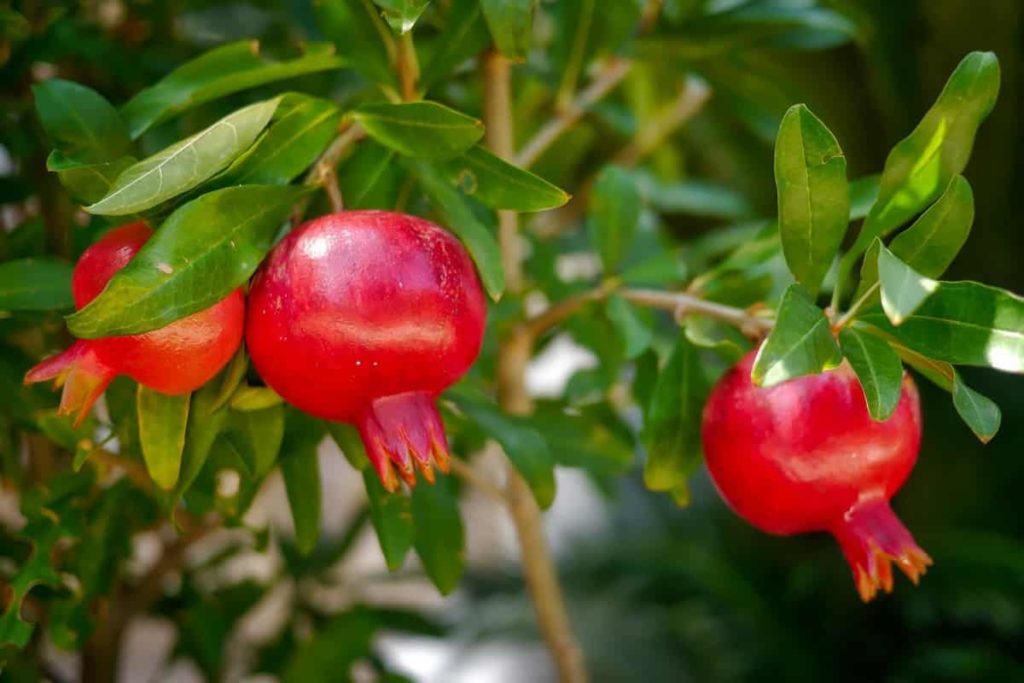
Pomegranate seeds, pulp, and juice are both tart and sweet. Pomegranate’s bright red seeds can be used as garnishes for salads, fruit cups, and desserts. Pomegranate trees are not only grown to make their fruits or juices, but they also make quite unusual ornamental trees. Orange-red flowers you see before fruit. You can also grow Pomegranates in a pot, provided you prune them regularly.
How to grow Pomegranate from seed to harvest
How long do Pomegranates take to grow from seed?
- Pomegranate trees can reach 33 feet and live much longer, although their economic lifespan is usually between 12 and 15 years.
- Once established, they are pretty drought-tolerant, making Pomegranates suitable for a mild desert climate. However, your new plant may take 3 to 5 years to bear fruit.
- Somewhat drought-tolerant, the Pomegranate tree is perfect for the sunny and warmest places in the yard that can scorch other plants. In general, although a Pomegranate tree can flower or produce small fruits at an earlier age, if it grows in a place where it is happy, it will not start producing large fruits until at least the 4th year of its age. So, planting a 3-year-old tree may take only a year after planting to start producing the fruit.
- It is an attractive plant with bright green leaves and reddish flowers. Flowering begins in late spring and continues into the summer; under appropriate conditions, the fruit should mature after 5 to 7 months.
Do Pomegranates grow true from seed?
- The maintenance of Pomegranate trees is usually easy, requiring minimal maintenance once planted.
- It is possible to grow Pomegranate from seeds but not necessarily desirable. Propagation through cutting is a more reliable method, as cutting will retain the characteristics of the parent plant. Seed-grown trees can lead to diversity, even among the seeds of the same plant. However, seed harvesting and growing are easy, and propagating this tree from seed can be an interesting project in genetic diversity.
In case you missed it: 15 Common Pomegranate Tree/Plant Problems: How to Fix Them, Solutions, and Treatment
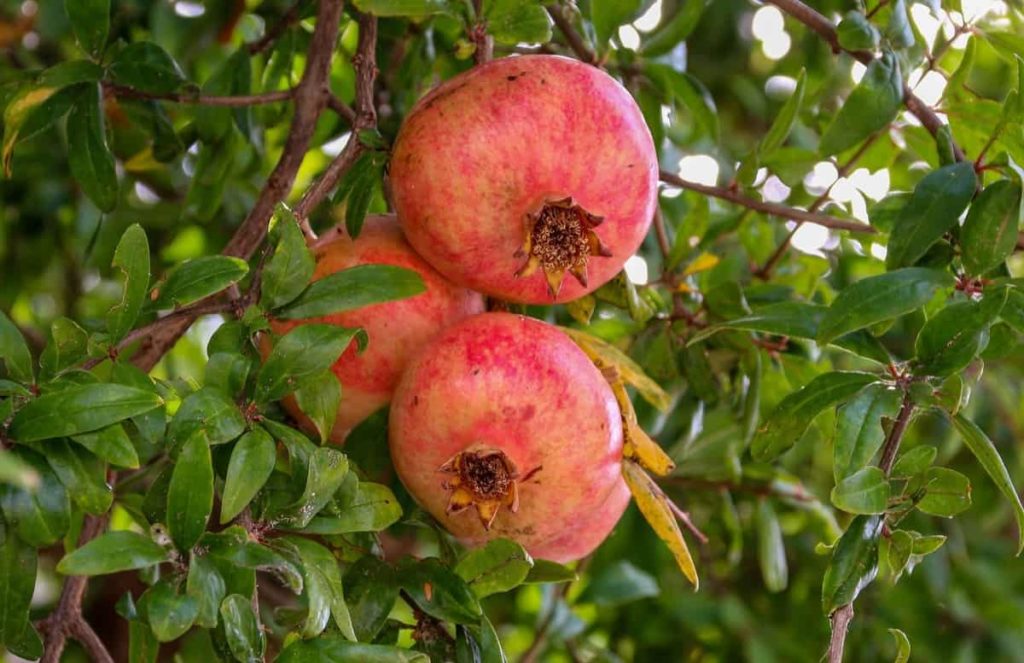
How do you start a Pomegranate seed?
- You should start Pomegranate seeds indoors in the middle of winter so they can be a couple of months to grow before the spring planting season. Remove some seeds, wash them in cold water, and then rub them with a paper towel to remove the pulp. Let the seeds dry for a few days to prevent them from rotting.
- Start Pomegranate seeds indoors, ideally in the middle of winter, so that you can transplant them in large containers or outdoors when the last frost passes in the spring. When starting Pomegranate seeds, they should be planted 1/4 inch deep in the seed starter. Be sure to plant only one seed per starter cell.
- Place the pot in a place of direct sunlight or bright light after planting; Pomegranate trees thrive in full sun. Be patient, as seeds take four to six weeks to sprout.
Can Pomegranate grow in pots?
- The Pomegranate tree is relatively small; its dwarf varieties are two feet high and can thrive in pots, making it a good option for a container gardener.
- Despite their eccentric appearance, Pomegranate trees are amazingly suitable for growing indoors. Unlike many other fruit trees, they have a shallow root system which is a good match for container growth.
- While growing a tree in a container isn’t particularly difficult, it requires regular maintenance in its early years. If you choose to grow it from infancy, be prepared to prune and trim it enough times.
- Generally, it is an easy tree to grow in a container, especially once it has fully matured and no longer requires much care.
Do you need two Pomegranate trees to produce fruit?
- Most Pomegranates are self-productive, which means they don’t need any other trees to thrive, as flies do all the work. Planting another Pomegranate nearby can increase fruit production on both plants. A little cross-pollination doesn’t hurt, but it’s not necessary.
- If you have multiple trees, go from one tree to another from a cross-pollinate, increasing the crop. Another option is to lure as many bees as possible towards the tree. Never spray pesticides. Finally, add pollen-filled wildflowers and other pollinator-attracting flowers to your garden to attract the bee that can be busy pollinating Pomegranates.
What kind of soil do Pomegranates like?
- Pomegranates grow well in deep loamy soils but will still grow quite well in sandy and clay soils. Trees are moderately acid tolerant in minor alkaline soils and grow best in the soil pH range of 5.5 to 7.2. Though Pomegranates can withstand short periods of standing water, they prefer well-drained soil.
- Although Pomegranates will tolerate most of the average garden soil, they grow best in fertile, deep, loam soil rich in humus, like most other fruit trees. Pomegranates prefer well-drained soil. Consistently soggy or wet soil can cause problems with their roots.
- Pomegranates can adapt to various soils, ranging from acidic sandy loams to alkaline calcareous soils and everything in between. In India, they are known to grow in rocky gravel. The only soil that will not support Pomegranates is heavy clay, as soil with excessive clay presents drainage problems.
In which month we can grow Pomegranate?
- You can find Pomegranate gardens in India throughout the year. However, the best-quality Pomegranates came to the markets during the monsoon season. The seeds of these fruits are planted in February and March.
- Pomegranate trees require enough heat to grow and ripen fruit. This fruit is usually seasoned in the northern hemisphere from October to February and from March to May in the southern hemisphere.
- Usually, Pomegranate trees will produce a reliable harvest two to three years after planting. They thrive from mid-spring to autumn, and fruits set in March or April will be ready for harvesting between August and October, depending on their types.
- When harvesting Pomegranate fruit, when the fruit is fully ripe and dark red because it does not continue to ripen after harvest. Start picking Pomegranates when you tap them with your finger and when the fruit makes a metallic sound.
How often do you water a Pomegranate?
- You must be watered on light soil twice a week and on clay soil once a week. You should soak the entire root system deeply, which will take about 40 to 50 minutes. Pomegranates should get at least an inch of water a week for the best growth and yield.
- It is better to soak the tree less frequently instead of giving it light water daily. Pomegranate trees require very little water during the dormant season because they are not actively growing; therefore, you should be careful not to have too much water. Similarly, Pomegranate trees are drought-tolerant and require less water a few years after planting. Water is essential during dry spells. The fruits can fall prematurely if not watered properly during a dry spell.
- After planting your Pomegranate seedlings, irrigate them every 7 to 10 days to provide about 5 to 6 inches of water to your new tree every ten days.
How much space do Pomegranate trees need?
- The spacing of Pomegranates is about 15 feet apart. Pomegranates grown as shrubs can be 10 to 15 feet long and wide. Plants can be trained in a single stem and cut as a small tree up to 20 feet long or 10 to 15 feet long and wide or less.
- The distance will depend on how you plan to use your Pomegranate tree. Some farmers use them as spreading bush hedges, which can be kept at a distance of about 6 to 9 feet. For those used for fruit production, it is better to place them at a distance of about 15 feet.
In case you missed it: How to Prepare the Soil for Pomegranate Plants/Trees: Best Soil Mixture, Ph, and Compost
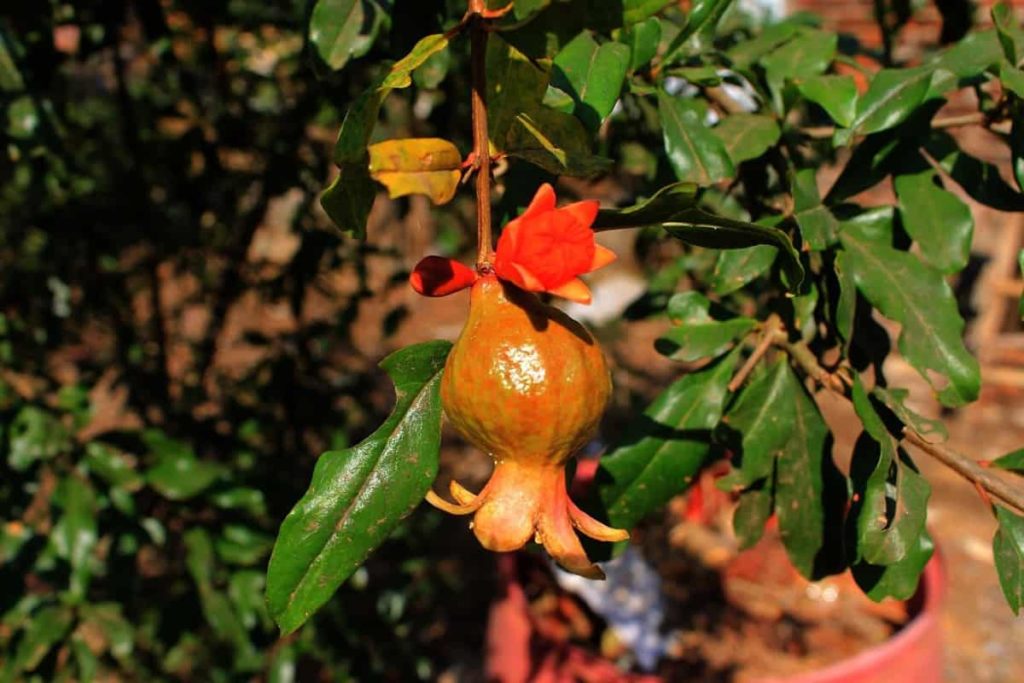
How much fruit does a Pomegranate tree produce?
Each tree can produce a crop of 20 to 25 fruits in the fourth year. In the tenth year, the yield increases from 100 to 150 fruits. In well-managed orchards, the average annual yield can be 200 to 250 fruits or about 75 pounds per tree. Pomegranates are usually eaten fresh.
Do Pomegranates need fertilizer?
- Fertilizer is not always required for Pomegranate trees. However, if the plant is doing poorly, especially if it is not bearing fruit or the yield is minimal, a fertilizer is recommended for Pomegranate trees.
- Pomegranate, being an orchard crop, is a heavy feeder of nutrients. The recommended fertilizer dose is 600 to 700 grams of nitrogen, 200 to 250 grams of P2O5, and 200 to 250 grams of K2O per tree annually.
- The Pomegranate tree needs proper nitrogen for optimal growth, as nitrogen supports leaf growth and flower production, ultimately establishing fruit. You can use ammonium sulfate, a high nitrogen fertilizer, or a balanced 10-10-10 formula, starting in the spring when the tree begins to show new growth.
- Every year, in March and November, feed your Pomegranate tree 900 grams to 1.3 kg of 8-8-8 fertilizer. As your new tree reaches maturity, consider modifying the soil with compost instead of fertilizing it. Once your seedlings reach 2 feet, cut out all but 4 or 5 of the best-looking shoots.
How do you grow a good Pomegranate?
- Pomegranates need a lot of sunlight to thrive and produce fruit. Look for an area that receives at least 6 hours of direct sun. Good drainage is crucial for Pomegranate trees, but they tolerate almost any soil, even poor or alkaline. Plant Pomegranates in a hole deep and twice as wide as a nursery pot.
- Pomegranates need full sun. Keep an eye on weather reports and move the plant to a sunny window indoors if the temperature threatens to drop below 4°C. Water the tree deeply once a week, possibly during the long summer months.
- The old wood will produce large fruits, so cutting Pomegranates more like a tree than a bush will help. It is essential to ensure that Pomegranates get adequate water during fruit formation.
Why are my Pomegranates falling off the tree?
- Naturally, insufficiently pollinated young Pomegranates will be shed. This may be due to the insufficient presence of pollinator helpers (like flies) during the bloom time of trees. Often the fruit that is dropped is malformed with very few seeds, another effect of insufficient pollination.
- Young Pomegranate trees suffer from moderate amounts of fruit drops. This proclivity increases in stressful conditions and can be controlled with proper care.
In case you missed it: Best Fertilizer for Pomegranate Tree: Homemade, Natural, Organic, and Compost Manure
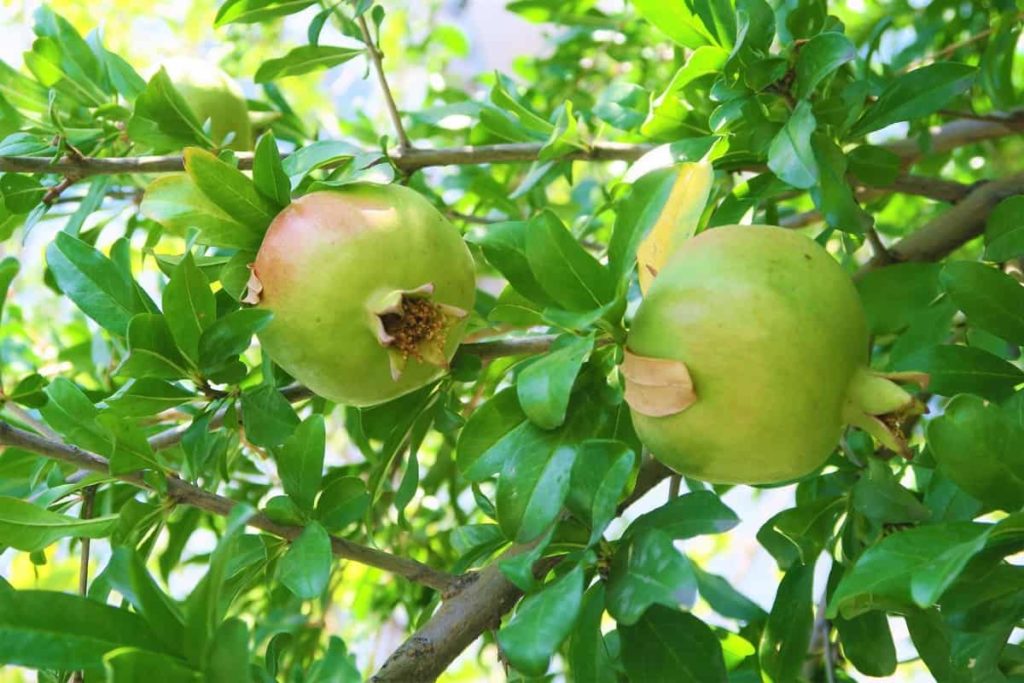
Why is my Pomegranate not producing fruit?
- Male Pomegranate flowers fall naturally as non-fertilized female blooms, while fertilized female flowers remain to bear fruit. Pomegranate trees start blooming in May and continue until early autumn.
- Pomegranate trees need to mature to produce fruit for three to five years. Before that, as long as the tree is watered, fertilized, properly pollinated, and cleared of pests and diseases, a little drop of Pomegranate flowers is natural, and there is no cause for danger.
- The main reasons for not growing Pomegranates are usually water, pollination, sunlight, and fertilization. Pomegranates are drought-resistant, but they need additional irrigation to set fruit.
Should Pomegranate trees be pruned?
- The best time to prune a Pomegranate tree is in late winter before the buds break down but after the risk of frost has passed. You can prune suckers and other odd branches as they appear in the growing season. The tree should only need light annual pruning if it is appropriately developed and maintained.
- After the third year, you’ll only need to prune your Pomegranate each year to encourage fruit production. Pruning your Pomegranate will reduce fruit production, but you’ll want to do heavy pruning after a year with very little growth to re-invigorate your Pomegranate.
Do Pomegranates need full sun?
- Pomegranates need full sun. Water the tree deeply once a week, possibly during the long summer months. Pomegranate trees need a lot of sunlight daily to thrive, so make sure your tree container is full of sunshine. They can tolerate partial shade if necessary (although this is not ideal).
- Pomegranate should be planted in full sunshine, like a long hot summer, even though it sets more fruit after winter. It resists droughts but grows better with a good water supply;
- Pomegranate shrubs can be grown in partial shade but should ideally be kept somewhere with maximum sun and heat. Your tree should get full sun for at least six hours daily for a good harvest.
Can Pomegranate tree survive winter?
- Pomegranate is common in tropics, sub-tropics, and sub-temperate areas and adapts well to areas with warm, dry summers.
- When Pomegranate trees are cold in winter, maintain temperatures above 15°C, so the plants are not entirely dormant. Position them so they are not in a draft or near heating vents whose hot, dry air will damage the leaves.
Why do my Pomegranates split open on the tree?
- If there is a sudden arrival of water after a dry spell (rain or no water), the cells inside the fruit spread faster than the skin cells. Since the skin cells don’t spread so fast, they separate, resulting in a rupture.
- You can prevent your tree from splitting by heavily mulching it with at least 3 inches of organic mulch and putting it on a watering schedule once it blooms. Water without soaking the root system every few days will evenly help prevent water-mulch evaporation, so there’s no need to do more.
In case you missed it: Pomegranate Growing Tips, Ideas, Techniques, Secrets
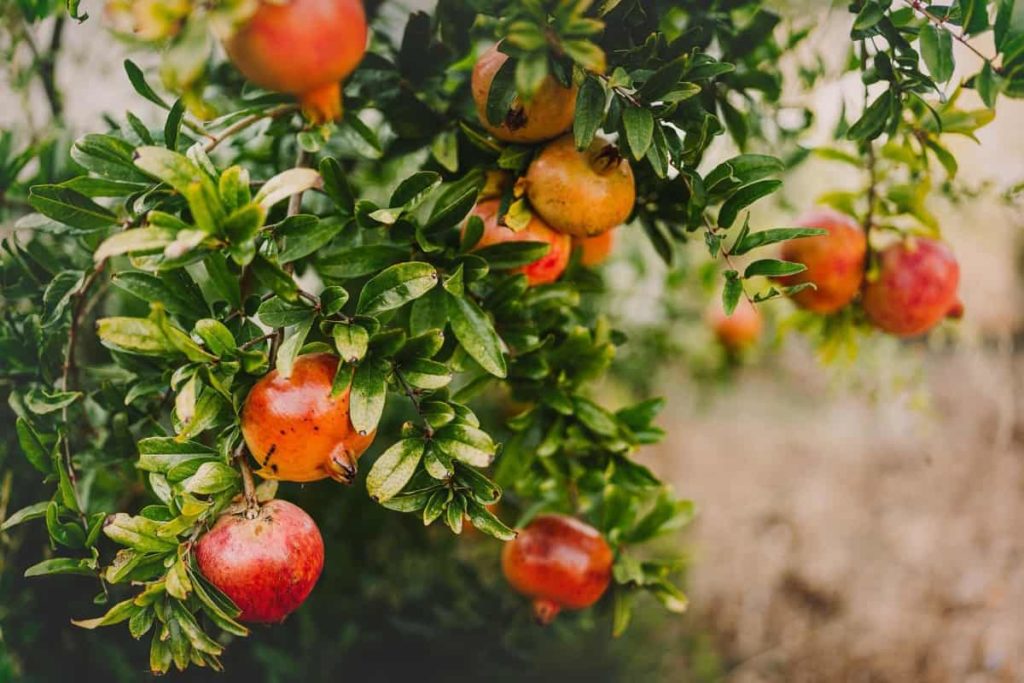
Can I grow a Pomegranate tree from a branch?
- Growing a Pomegranate tree by cutting requires cutting hardwood taken at an appropriate time. You should take a Pomegranate tree cutting at the end of winter. Each cutting should be about 10 inches long and taken from year-old wood that is 1/4 to 1/2 inch.
- You should remove leaves and buds and dip the cutting end in hormone powder. You can either place the main ends of the cuttings in a container containing several inches of water or dip them in a pot with pot soil.
How long does it take for Pomegranate cuttings to root?
- Cutting or suckers can take up to one to two months to root, but you’ll notice leaf buds forming when the roots are established.
- Normally, a cutting will produce fruit in about two-and-a-half to three years. Some plants can bear fruit after just one year. Pomegranate itself is fruitful but can also produce fruit after cross-pollination by insects. Cross-pollinated trees produce more yields.
Why is my Pomegranate not flowering?
- Insufficient light is the main reason why Pomegranate plants fail to produce flowers. You should provide at least 8 to 10 hours of direct sunlight daily, especially from spring to autumn. The higher the sun and warmer the temperature of the growing season, the better.
- The main reasons for not growing Pomegranates are usually water, pollination, sunlight, and fertilization. Pomegranates are drought-resistant, but they need additional irrigation to set fruit.
Why are the leaves of my Pomegranate turning yellow?
- After climate change, the most common reason why Pomegranates turn yellow is that homeowners water them more. It is natural to rear fruit plants, but Pomegranates, unlike most fruit-bearers, are native to dry, arid areas and don’t perform well with a lot of water.
- If the Pomegranate tree is losing leaves, it may be due to natural, non-harmful causes such as remorseful annual leaf drops. Pomegranate leaves turn very yellow before falling to the ground in the autumn and winter.
- Water more often when it gets hot. You shouldn’t water more than once every other day in the hottest weather. Leaf yellowing and drop water can be temporary problems with many fruit trees.
In case you missed it: Growing Pomegranate In The Backyard
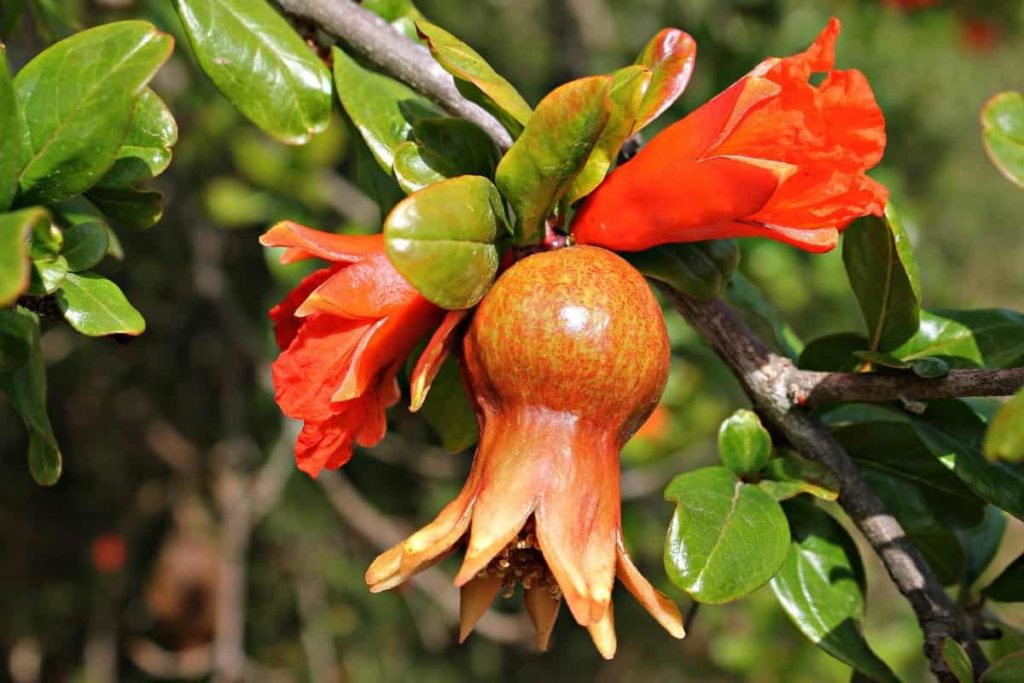
Conclusion
Pomegranate fruit grows on smaller shrubs or ornamental trees, and flowering plants thrive in warm climates. Pomegranate trees are easy to grow in the right conditions and ready for winter harvesting. Tasty arils are deliciously fresh, or you can make Pomegranate juice, add pods to salads, or use them in cooking. The Pomegranate tree is easier to grow than other fruit trees and should be part of your scenario. With patience and caution, you could get ripened Pomegranates in less than three years.
- How to Grow Tomatoes Organically at Home: A Comprehensive Guide
- Organic Gardening on a Budget: Low-Cost Methods and Materials
- Gongura Seed Germination and Planting Methods
- Cabbage Seed Germination and Selection
- Broccoli Seed Germination and Selection
- Asparagus Seed Germination and Variety Selection
- Seasonal Flower Gardening: Best Practices for Spring, Summer, Fall, and Winter
- How to Grow Hibiscus from Flower
- Plantation Ideas for Home Decoration: A Beginners Guide
- Flower Garden Designs and Layouts for Beginners
- Planting and Spacing Techniques in Papaya: A Beginner’s Guide
- Growing Gold: Essential Techniques for Planting Pineapples
- How to Make Kalanchoe Plant Bushy: Home Remedies and Solutions
- 11 Reasons Why Your Gardenia is Not Blooming: Home Remedies and Solutions
- Eco Elegance: The Guide to Designing a Drought-Tolerant Landscape
- Gardening on a Slope: Strategies for Hillside Landscaping
- Nourish and Flourish: Top Organic Mulches for Thriving House Plants
- Everything You Want to Know about Indian Mogra Flower: Discover Uses and Growing
- Green Thumb Success: Expert Tips for Cultivating Greenhouse Pumpkins All Year Round
- Maximize Growth & Flavor: The Ultimate Guide to Companion Planting in Herb Gardens
- How to Control Rhododendron Problems Naturally: Home Remedies and Organic Ways to Fix Them
- Natural Magic: The Remarkable Benefits of Cinnamon for Plants
- Best Steps to Revive Dying Tulip with Natural and Organic Treatment
- 10 Reasons Why Your Angel Trumpet is Not Blooming: Remedies and Treatment
- How to Fix Periwinkle Leaf and Flower-Related Problems: Natural Remedies and Solutions
- How to Fix Zinnias Leaf and Flower Problems: Discover Natural and Home Remedies
- Organic Steps to Induce Lemon Tree Flowers: A Comprehensive Guide
- Bloom Booster: Crafting the Perfect Homemade Bougainvillea Fertilizer
- Optimizing Growth: A Guide to Applying NPK Fertilizer for Potted Plants
- 10 Best Homemade Fertilizers for Rubber Plant: DIY Recipes and Application Method
- How to Boost Female Pumpkin Flowers: Effective Steps for More Flowers and High Yields
- Transform Your Indoor Garden: Top Benefits of Pink Salt for Houseplants
- 10 Best Homemade Fertilizers for Peacock Plants (Calathea): Easy DIY Guide
- Unlock Blooms: 9 Reasons Why Your Potted Chrysanthemum is Not Blooming
- 8 Reasons Why Your Potted Hibiscus is Not Blooming: Fix it with Simple Solutions
- Unlock Blooms: 9 Key Reasons Your Potted Frangipani Won’t Flower